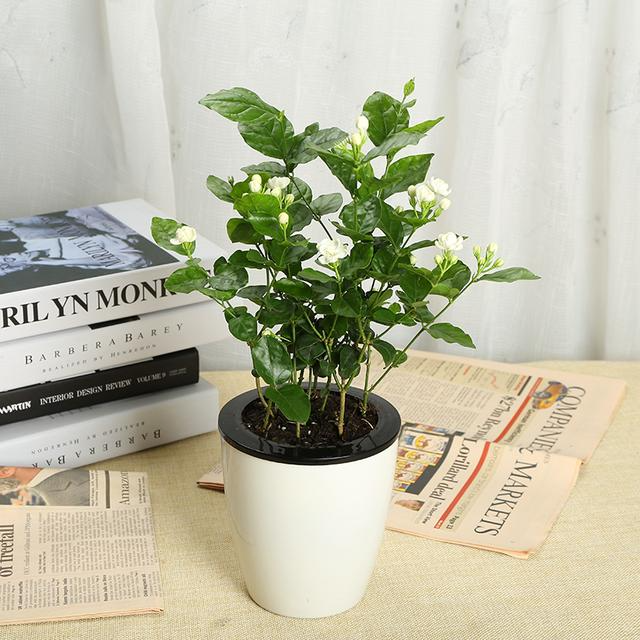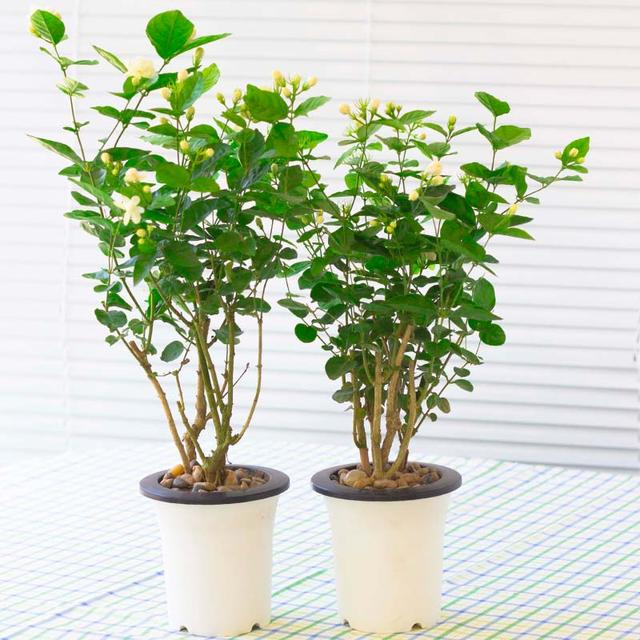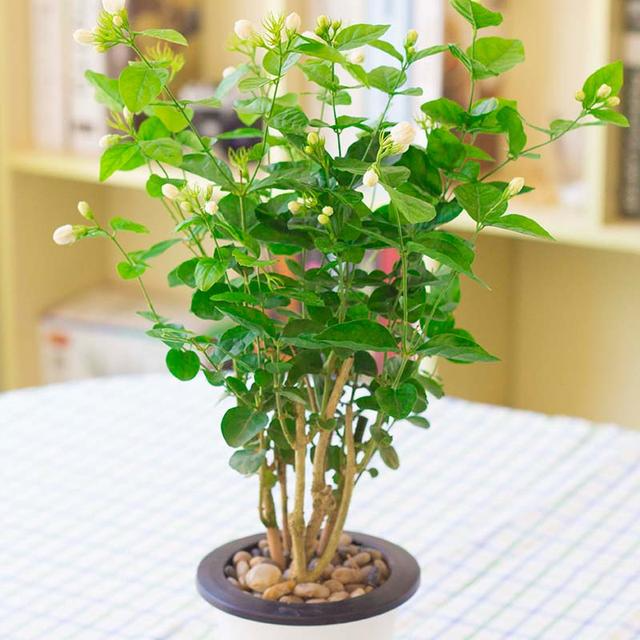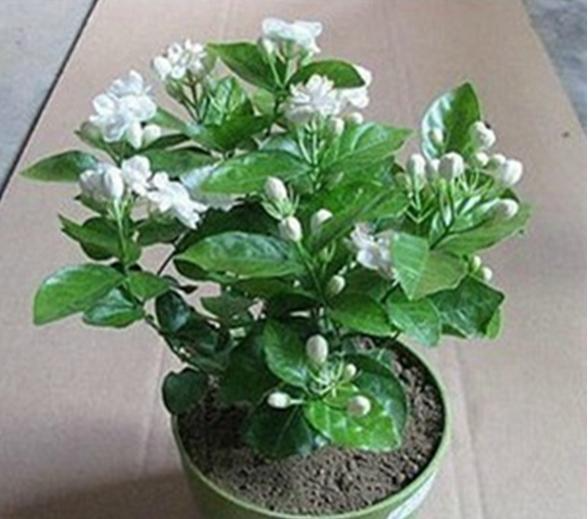[Flower Knowledge] Potted Jasmine Cultivation Techniques
Cultivation Techniques of Potted Jasmine
Jasmine, also known as jasmine flower and tea flower, is an evergreen upright or climbing shrub of the genus Jasmine in the family Oleaceae. Jasmine was introduced from southwestern Asia as early as the Han Dynasty more than 1,700 years ago. The earliest cultivation area was in Hainan, Guangdong, Guangxi and Fujian coastal areas, and then gradually moved northward to the Yangtze River Basin. Because of its exquisite plant shape, lush branches and leaves, emerald leaves, jade-like flowers, long-lasting fragrance, strong and non-turbid fragrance, it is praised by the world as a treasure among flowers and trees and "the best fragrance in the world". Jasmine has a wide range of uses and has high ornamental, tea and medicinal value. In addition to being used directly for smoking scented tea, jasmine can also be used to extract extracts and essential oils for the spice industry. It is one of the main raw materials for high-end daily cosmetics flavors and high-quality soap essences, especially an important raw material for preparing high-end perfumes and flavors. Jasmine can be potted or used as a flower hedge for viewing, and is often worn as a corsage or flower basket decoration. It has always been loved by people. At present, the places where jasmine is cultivated on a large scale in China, such as Fujian, Guangdong, Guangxi, Hunan, Sichuan, etc., are mainly used to harvest fresh flowers for making jasmine tea, while Zhejiang, Jiangsu, Anhui, Jiangxi and other provinces mainly use them as potted plants for viewing. In short, the cultivation of jasmine has good economic benefits. Many years ago, it has become the country with the largest jasmine cultivation area and the largest flower production in the world.

Jasmine potted plants are also relatively common potted plants. With the continuous improvement of people's living standards, the requirements for cultural level are getting higher and higher. More and more people like to use potted plants for indoor decoration. The demand for potted plants is increasing, and the requirements for potted plant quality are also getting higher and higher. However, the jasmine potted plants cultivated by traditional methods have few flowers inside, poor quality, branches are easy to wither, the survival rate is low, and the cultivation cost is high.
(1) Selection of cuttings: Choose jasmine branches that are healthy, well-developed, and free of pests and diseases. The length of the jasmine branches should be 10-15 cm.
(2) Substrate selection: a mixture of red soil and mulberry twig and sugarcane pith in a weight ratio of 1:(2-3) is mixed evenly and left for one week, and then placed in a container to obtain a culture substrate; the mulberry twig and sugarcane pith mixture is obtained by mixing mulberry twig particles and sugarcane pith evenly and then adding composite bacteria for fermentation; the container is any one of a clay pot, a ceramic pot, and a plastic flower pot;
(3) Cutting: In February and March, take the selected jasmine branches, soak the lower part of them in disinfectant rooting liquid for 0.5-1 minute, insert them into the cultivation medium and place them outdoors. When the sun is strong, shade is required. The depth of the jasmine branches inserted into the cultivation medium is 1-3 cm. 10-12 jasmine branches are inserted into an 18 cm diameter container;
(4) Water and fertilizer management: After the jasmine branches are cut, water the culture medium thoroughly with clean water, and then water it thoroughly again before the culture medium is dry and cracked. Water in the morning and water with common water and fertilizer in the evening. The amount of water and fertilizer for each pot is 50-100 ml/time; dry and uncracked culture medium means that the surface of the culture medium is dry and not moist, but has not cracked yet;
(5) Top dressing and pruning: Top dressing should be done one week before pruning. Naturally fermented farmyard manure should be used for top dressing. Pruning is to top and shape the branches of jasmine to encourage more branches. Prune once every 1-2 months, for a total of 3 times. Spray a 0.5-1% paclobutrazol aqueous solution by weight 10-15 days after the last pruning. Spray a 3-5% potassium dihydrogen phosphate aqueous solution by weight 20-25 days later.
(6) Finished products are put on the market: After top dressing and pruning, when the new branches and leaves of the jasmine branches grow to 15-20 cm long, they can be put on the market. Apply top dressing once more before putting them on the market.
The composite bacteria is prepared by culturing the following bacterial species in parts by weight:

Candida utilis 12-17;
Bacillus subtilis 8-15;
Trichoderma viride 8-10;
Fiber decomposing bacteria 2-5;
Yeast 2-3.
The preparation process of the mulberry branch and sugarcane pith mixture is as follows:
(1) taking 80-90 parts by weight of mulberry branch granules and 40-45 parts by weight of sugarcane pith for later use, wherein the mulberry branch granules are obtained by crushing the mulberry branch into particles of less than 0.5 cm in size;
(2) Take 1-3 parts by weight of the composite bacteria and put them into a container, dissolve them with 10-15 parts by weight of 24-28°C water, and stir them thoroughly to dissolve them into a composite bacteria liquid;
(3) After the above-mentioned mulberry branch pieces and sugarcane pith are mixed evenly, the composite bacterial solution is added and mixed evenly. After fermenting at 28-37°C for two days, an appropriate amount of clean water is added and stirred until the mulberry branch pieces and sugarcane pith feel moist to the touch. After fermenting for another 3-6 days, a mulberry branch and sugarcane pith mixture is obtained.

The jasmine branches are obtained from jasmine trees with an age of 2 to 5 years.
The disinfection rooting liquid is prepared from rooting powder, carbendazim and clean water, and the weight ratio of the rooting powder, carbendazim and clean water is 1:1:200.
The thickness of the topdressing is 1-1.5 cm. The beneficial effects are:
1. The jasmine potted plant cultivation method of the present invention can improve the survival rate of potted plants, and the cultivation survival rate is as high as 99%, and customers can easily raise them after buying them.
2. The nutrient soil for the potted plants was screened, and a mixture of red soil and mulberry branches and sugarcane pith was selected as the matrix. The jasmine flowers grew more vigorously. The mulberry branches, which are by-products of mulberry planting and silkworm breeding, and the sugarcane pith, which are a by-product of sugarcane production, were fully utilized. The obtained cultivation matrix was fertile and low in cost, which could be scaled up and easily promoted and applied.
3. Cultivating shrub-type jasmine into a single trunk overcomes the original problem of unclear trunk, many branches, short crown, low effective light utilization rate, and easy baldness in the inner trunk. The trunk thickness and crown width of the cultivated tree are significantly increased, the trunk is upright and tall, the number of flowers is large, the flowering period is long, the number of young buds picked is also increased, and the picking period is also extended.
4. After cutting the jasmine branches, water the cultivation medium thoroughly with clean water, and then water it thoroughly again before the cultivation medium dries up and cracks. Water in the morning and use commonly used water and fertilizer in the evening. After three prunings before listing, the resulting potted plants will be short and plump with many flowers, which greatly increases its ornamental value.
